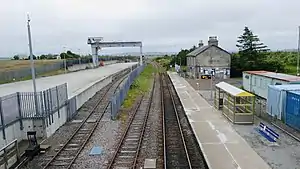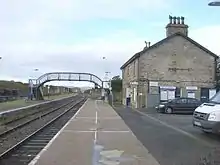 The platform and freight terminal at Georgemas Junction, looking west | |
| General information | |
| Location | Georgemas, Highland Scotland |
| Coordinates | 58°30′49″N 3°27′06″W / 58.5135°N 3.4518°W |
| Grid reference | ND155592 |
| Managed by | ScotRail |
| Platforms | 1 |
| Other information | |
| Station code | GGJ[2] |
| History | |
| Original company | Sutherland and Caithness Railway |
| Pre-grouping | Highland Railway |
| Post-grouping | London, Midland and Scottish Railway British Railways |
| Key dates | |
| 1874 | Opened |
| Passengers | |
| 2018/19 | |
| 2019/20 | |
| 2020/21 | |
| 2021/22 | |
| 2022/23 | |
| Notes | |
Passenger statistics from the Office of Rail and Road | |
Georgemas Junction railway station is a railway station located in the Highland council area in the far north of Scotland. It serves several rural hamlets in the historic county of Caithness, including Georgemas, Roadside and Banniskirk. It is also the nearest station to the village of Halkirk, which lies approximately 1.6 miles (2.6 km) west of the station.
Georgemas Junction is the penultimate station on the Far North Line from Inverness to Wick, 147 miles 22 chains (237 km) down the line from Inverness.[3] Immediately to the west of the station lies a junction of the same name, where the branch to Thurso spurs off northwards; mileages on this branch are measured from the station.[3] This junction is the northernmost railway junction in the United Kingdom.
The station has a single platform which is long enough to accommodate a six-carriage train.[4] The station is managed by ScotRail, who operate the services at the station.
History

The station was built by the Sutherland and Caithness Railway (S&CR). The station buildings were designed by Murdoch Paterson and it opened on 28 July 1874[5] and on that date the Highland Railway absorbed the S&CR and operated the newly completed line from Helmsdale to Thurso and Wick. A wrought-iron turntable of 45 feet (14 m) diameter built by the Railway Steel and Plant Company of Manchester was installed at the station.[6]
In 1902, Donald Mackenzie, station master was appointed first station master of Dornoch railway station.[7]
From 1 January 1923 the station was operated by the London Midland and Scottish Railway.
Accidents and incidents
At the end of February 1937 trains were stranded at Georgemas Junction because of heavy snow. A goods train from Inverness got stuck in a drift 9 feet (2.7 m) deep. An engine with a snow plough was also stuck at the same location.[8]
Trains to and from Thurso
Until diesel multiple unit trains were introduced by British Rail in the early 1990s, all trains on the Far North Line were locomotive-hauled, initially by Highland Railway steam locomotives, then by LMSR steam locomotives and latterly by British Railways steam and finally Class 37 diesel locomotives. Northbound passenger trains would divide at Georgemas Junction, with the rear portion for Thurso and the front portion for Wick. A locomotive was stabled at Georgemas Junction to haul the Thurso carriages.
Following the introduction of Class 156 diesel multiple units on the line, trains were always composed of two trainsets (four cars) and at Georgemas, these would split in half with the front portion heading to Wick, the rear to Thurso. This practice was halted with the introduction of Class 158 sets which operate as single sets - on arrival at Georgemas Junction from Inverness, trains reverse to reach Thurso, and then reverse again from Thurso back to Georgemas Junction (stopping a second time) and on to Wick. An easement to the National Routeing Guide allows passengers for Wick to stay on the train between Georgemas Junction and Thurso, which would otherwise technically be off-route.[9]
Georgemas Junction station has been used for several freight services. In the early 2000s, EWS operated a freight train for Safeway supermarket, running from Mossend to Georgemas. Containers were unloaded at Georgemas, then transported by road to Wick and Thurso, and by ferry to Orkney.[10] In 2012, the former platform 1 and the footbridge was removed when Direct Rail Services constructed a new freight terminal at Georgemas - this has been used by trains taking nuclear material from Dounreay to Sellafield.[11] As this platform was located on a passing loop which did not connect directly to the Thurso branch, it was very little-used by passenger trains, since all services through the station run to or from Thurso.[12] The purpose of the passing loop dates back to the era of loco-hauled trains which divided/attached at the station – an Inverness-bound train from Wick would loop around the Thurso portion standing on the second (remaining) platform, and attach to it from behind.
Facilities
Facilities at this station include a payphone that accepts card and coins, a waiting room and designated seating area, a cycle rack with 10 spaces, and a free car park with 2 spaces. The nearest bus stop to the station is located 850 metres (0.53 mi) to the north.[13]
Passenger volume
| 2002–03 | 2004–05 | 2005–06 | 2006–07 | 2007–08 | 2008–09 | 2009–10 | 2010–11 | 2011–12 | 2012–13 | 2013–14 | 2014–15 | 2015–16 | 2016–17 | 2017–18 | 2018–19 | 2019–20 | 2020–21 | 2021–22 | 2022–23 | |
|---|---|---|---|---|---|---|---|---|---|---|---|---|---|---|---|---|---|---|---|---|
| Entries and exits | 1,129 | 1,108 | 1,018 | 989 | 893 | 1,500 | 1,482 | 1,630 | 1,682 | 1,906 | 1,652 | 1,696 | 1,572 | 1,502 | 1,320 | 1,576 | 1,570 | 234 | 1,032 | 1,318 |
The statistics cover twelve month periods that start in April.
Services

On weekdays and Saturdays, there are four trains per day each way between Inverness and Wick, resulting in 8 trains per day to Thurso, as all trains in both directions go to Thurso on their way to Inverness or Wick. On Sundays, the frequency is reduced to one train per day each way, meaning two trains go to Thurso.[12]
| Preceding station | Following station | |||
|---|---|---|---|---|
| Scotscalder or Forsinard |
ScotRail Far North Line |
Wick | ||
| Thurso | ||||
| Historical railways | ||||
| Halkirk line open, station closed |
Highland Railway Sutherland and Caithness Railway |
Bower line open, station closed | ||
| Hoy line open, station closed |
||||
References
- ↑ Brailsford 2017, Gaelic/English Station Index.
- ↑ Deaves, Phil. "Railway Codes". railwaycodes.org.uk. Retrieved 27 September 2022.
- 1 2 Bridge, Mike, ed. (2017). TRACKatlas of Mainland Britain: A Comprehensive Geographic Atlas Showing the Rail Network of Great Britain (3rd ed.). Sheffield: Platform 5 Publishing Ltd. p. 104. ISBN 978-1909431-26-3.
- ↑ Brailsford 2017, map 20E.
- ↑ "The Sunderland and Caithness Railway". The Scotsman. British Newspaper Archive. 27 July 1874. Retrieved 14 August 2016 – via British Newspaper Archive.
- ↑ "The Sutherland and Caithness Railway". John o’Groat Journal. Scotland. 9 July 1874. Retrieved 15 July 2017 – via British Newspaper Archive.
- ↑ "Opening of the Dornoch Light Railway". John o’Groat Journal. Scotland. 30 May 1902. Retrieved 30 August 2017 – via British Newspaper Archive.
- ↑ "Trains delayed". Aberdeen Journal. British Newspaper Archive. 1 March 1937. Retrieved 15 August 2016 – via British Newspaper Archive.
- ↑ "Routeing Guide Easements" (PDF). Archived from the original (PDF) on 17 July 2011. Retrieved 30 December 2010.
- ↑ "Supermarket containers being unloaded at Georgemas Junction, 2001". Am Baile. Highland Council.
- ↑ "Rail terminal is a major boost". John O'Groat Journal. 27 June 2012. Archived from the original on 4 July 2012. Retrieved 26 February 2013.
- 1 2 eNRT December 2021 Edition, Table 219
- ↑ "Facilities". ScotRail. Archived from the original on 25 January 2020. Retrieved 25 January 2020.
- ↑ "Estimates of station usage | ORR Data Portal". dataportal.orr.gov.uk. Retrieved 25 December 2023.
Bibliography
- Brailsford, Martyn, ed. (December 2017) [1987]. Railway Track Diagrams 1: Scotland & Isle of Man (6th ed.). Frome: Trackmaps. ISBN 978-0-9549866-9-8.
- Butt, R. V. J. (October 1995). The Directory of Railway Stations: details every public and private passenger station, halt, platform and stopping place, past and present (1st ed.). Sparkford: Patrick Stephens Ltd. ISBN 978-1-85260-508-7. OCLC 60251199. OL 11956311M.
- Jowett, Alan (March 1989). Jowett's Railway Atlas of Great Britain and Ireland: From Pre-Grouping to the Present Day (1st ed.). Sparkford: Patrick Stephens Ltd. ISBN 978-1-85260-086-0. OCLC 22311137.
External links
- Train times and station information for Georgemas Junction railway station from National Rail